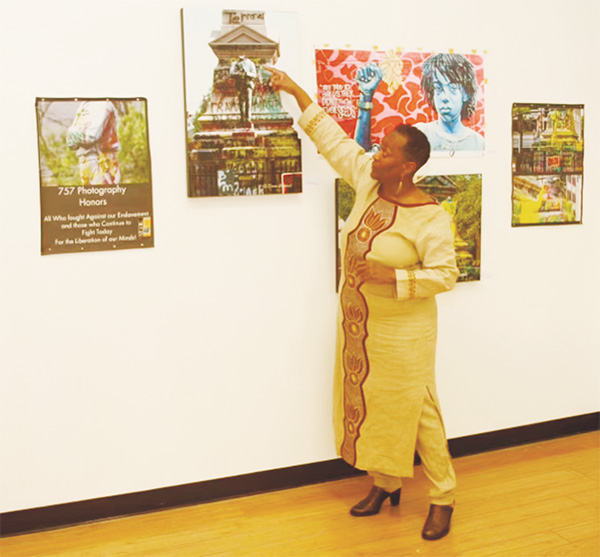Black Arts and Culture
Diana Chappell: Norfolk Social Activist, Folklorist, & Now, Photographer
Diana Chappell, known for her work as a social activist and folklorist, recently held her photography exhibition, “In the Spirit of Sankofa,” at the For All Handkind Gallery in Norfolk. This marks Chappell’s journey from activism to artistic photography, celebrating the stories and history of her community.
#DianaChappell #Norfolk #Photographer #Sankofa #Storytelling #Art

By Melissa Spellman
Staff Reporter
New Journal and Guide
Photographer Diana Chappell recently closed out her exhibition at For All Handkind Gallery located inside McArthur Mall in Norfolk. Chappell’s exhibition entitled “In the Spirit of Sankofa” began on March 1st as a part of Women’s History Month.
For All Handkind Gallery is owned by Kimberly McKinnis, an artist, curator, and adjunct professor at Old Dominion University. The gallery is a shared creative space with designated studios. The gallery is home to local artists Virginia Van Horn, Sculptor, Pamela Winslow, Painter, and Norfolk State University alumna Anjeanette Britton, Painter, and Diana Chappell, Photographer.
Chappell’s opening reception paid respect to Ghana’s Independence Day which was on March 6th. This is where she arrived at the theme “In the Spirit of Sankofa.” Sankofa (pronounced SAHN-koh-fah) comes from the Twi language of Ghana meaning to retrieve, to go back and get, to return. The Sankofa symbol represents the wisdom of learning from the past to help improve the future.
Known to many people as an activist and folklorist, it has taken time for Chappell to settle into her title as photographer. “It’s taken me awhile to see myself as a photographer. I’ve always considered myself a storyteller whether that was maintaining the family history or our ancestral history. Photography for me has been a way of better conveying those stories of our history and culture,” said Chappell.
In her journey as a photographer, she says that two things happened along the road to shape her into the photographer she is today. “First, I came to love the look of satisfaction in people’s faces when they saw nice reflections of themselves,” said Chappell. She says it’s not only the joy of people seeing their own photos but also when people can see themselves in the images that document our history.
She shares that the second thing that happened on her journey was learning to manipulate images. “When I first started, originally it was about telling the stories of our history and sharing the images. I never thought about manipulating the images,” said Chappell. In the beginning her focus was on capturing and documenting our history through photography. She went on to say, “On the way to becoming a photographer now I’m thinking more about how to manipulate images. I’m thinking more about the artistic side of it.”
Through learning to shape images she brings her work to life as art, becoming a photographer with an artistic eye. “When people look at these images they ask ‘are you a painter?’ I say no, that’s photography. That’s a real man that I captured at a Pow Wow,” said Chappell, referencing a photo taken at a local Native American Pow Wow event. She says it’s about controlling the outcome “I’m wanting to understand how to manipulate the images so that I can control what the final outcome looks like what people see,” she explained. In this latest exhibition, she believes has perfected her craft.
Diana Chappell is no stranger to readers of the New Journal and Guide. She has both worked for and freelanced for NJG since the 1970s. It was at the New Journal and Guide where she decided to go back to school to study photojournalism at NSU. Her roots are deeply planted in activism.
She has been an activist in this community since the mid 70s working as a founding member of The Black Vanguard Resource Center along with the late Anthony Lewis and Carolyn Johnson, a former professor at NSU. Chappell worked on the United Congress Against the Death Penalty during the early 1970s. As they founded the Black Vanguard Resource Center, they were committed to free Van Burton who was a Virginia Beach resident sentenced to life plus 20 years for a robbery charge that he did not commit.
The Black Vanguard also worked in conjunction with local churches and organizations to form the anti-apartheid coalition which raised material aid that was shipped to Southern Africa for refugees there. Working with the ILA International Longshoreman’s Association, they were able to send three shipments of material to Mozambique for Zimbabwe and refugees which the United Nations helped to fund with a $50,000 grant.
Chappell is the founder of the organization Women Against Violence working to save our youth during the 1990s as the community dealt with gun violence. She has travelled to Africa four times visiting Kenya, three visits to Ghana with her last trip being in 2019 documenting her last journey in a photo book entitled “2019 The Year of Return.”
During Covid she was featured in a news story entitled “Norfolk photographer captures grief and mourning during COVID” for her collection of photography at the height of the pandemic. She has also been featured as a hometown hero by Wavy TV-10 and featured in Distinction Magazine.
In recent years she has become involved in the education and coordination of local Kwanzaa programs. Her history in activism is long and varied going back to the 1960s. “I have been an activist. That’s the description that I have always used to describe myself,” she said. While Chappell clings to her title as activist, she has emerged as a photographer in pursuit of growth as an artist.
She is now one of four artists with studio space in For All Handkind Gallery. Chappell says she is still embracing herself as a photographer. She added, “I hope my next exhibit will reflect my growth from photographer to Artist.”















